Every new investor has to answer the question, “What loan grades do I invest in?” This is really important to ask because its answer has a weighty effect upon our overall experience. Those who choose safer grades will have a safer investment that may yield a lower than average return. Those who choose riskier grades may have a more volatile investment that yields a higher than average return.
So which grades are best? The answer: it depends on where you are in life, and everybody is different. Every investor’s circumstances will push him or her toward the best choice of loan grades for their specific situation.
Today we will explore the relationship of loan grades and risk tolerance in peer to peer lending. My goal is that, by the end of this article, you will be able to confidently identify your particular risk tolerance for investing at Lending Club or Prosper.
Risk/Return as Universal Truth
The concept of investor risk tolerance is fairly straightforward. Every investment in the world has a tradeoff between risk and return, with ‘risk’ meaning the wildness (volatility) of the investment and ‘return’ meaning the potential the investment has to make you money (yield).
For example, the more risk you take on, the higher the chance you have to earn a great return. However, you also increase your chances of having a poor or negative experience as well.
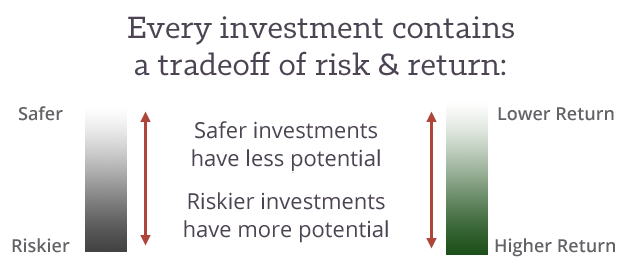
Here is a helpful chart that explains this relationship. Where you fall on the gradient above is your risk tolerance, or, your ability to tolerate a more volatile investment.
Some people have a lower risk tolerance. They are at a place in life where they really have to protect their savings, and losing money might be a major setback. Other people (like myself) are in a place in life where they are able to take on more risk. They have a greater risk tolerance. If they lost money on their investment, it would certainly be a bit of bad news, but they would remain good overall.
Risk/Return at Lending Club & Prosper
Using complex statistics, Lending Club and Prosper assign a grade to every loan on their platform. This grade is related to the interest rate each borrower will have to pay on their loan. For example, borrowers assigned a 7% interest rate on a loan typically have great credit history, and are more likely to pay their loan back than other borrowers. Thus, they are given an A-grade.
In peer to peer lending, our individual risk tolerance is related to the grade of the loans we invest in.
Both platforms have seven risk-grades they give their loans. Lending Club’s grades span from A to G, with A-grade being the safest. Prosper starts with the safe AA-grade, then grades A through E, and finally HR (high risk). In peer to peer lending, our individual risk tolerance is related to the grade of the loans we invest in.
Let’s take the risk/return chart from above and insert these seven loan grades:
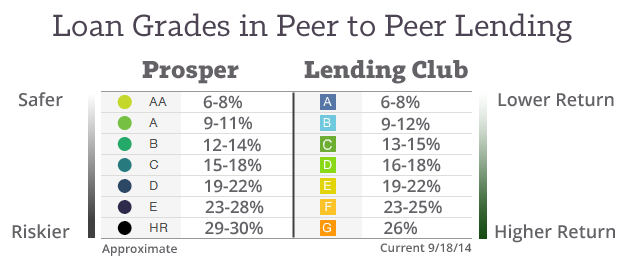
As previously stated, these grades indicate risk, like how A-graded loans are issued to safer borrowers who are more likely to pay them back. But a loan’s grade also communicates to investors the potential return for each loan. A-graded loans only have a 6-8% interest rate, so they may earn investors a 5% return after defaults. In this way, peer to peer loan grades communicate both a loan’s risk as well as its potential return.
Every loan at Lending Club and Prosper is prime-rated (but some are more prime than others)
It’s worth stating that every loan on these platforms has passed underwriting standards, and is therefore a decent investment. That said, the grades we choose greatly impact our return.
For example, I personally invest in D-G graded loans at Lending Club, and feel this approach has been the main reason my return has been higher than most investors. However, my returns are also more volatile than many investors, meaning my ROI goes up and down more regularly.
Other investors earn a lower return because they invest in the safer A-B grades, and this 5-7% return does not mean they have a worse investment. Studies have shown my D-G graded loans yielding poorly in scenarios like a drop in the national economy. But safe A-graded loans to borrowers with excellent credit fare much better. Further, the stability of A-grade loans may have a lower point of diversification than the rest, so beginning investors need just 80 A-grade loans ($2,000) to be fully diversified (AA-grade at Prosper).
See the presence of risk and return in peer to peer lending? Safer loans from trustworthy borrowers are less likely to default, are more consistent, and are more likely to survive a slowdown in the American economy. But they typically only earn investors 5-7% per year. Riskier peer to peer loans are more likely to default, particularly in a bad economy, but have historically earned investors an 8-10% return or more.
Four Types of Risk Tolerance at Lending Club & Prosper
To nuance this idea of risk tolerance, I’ve created four investor personas, each with a different peer to peer lending risk tolerance. Note: the loan grades these people choose are generalizations. Your particular allocation will likely be different.
“Duncan” from Delaware: Should not invest
 Duncan and his girlfriend are expecting a baby in six months. Actually, they just got engaged to be married, and Duncan paid for the ring with his Mastercard. Added to the student loans he has yet to pay back (at a 7% interest rate), Duncan is $34,000 in debt with no savings. He has been chipping away at this debt each month, but it’s tough work. He just heard about investing at Prosper and is intrigued.
Duncan and his girlfriend are expecting a baby in six months. Actually, they just got engaged to be married, and Duncan paid for the ring with his Mastercard. Added to the student loans he has yet to pay back (at a 7% interest rate), Duncan is $34,000 in debt with no savings. He has been chipping away at this debt each month, but it’s tough work. He just heard about investing at Prosper and is intrigued.
Duncan should not begin peer to peer lending. First, he needs to get his financial and social situation stable, pay off his debts, and establish an emergency fund.
“Mitch” from Maine: A lower-risk investor
 Mitch is a retired architect who used to build corporate offices. He is 78 years old. Through savvy budgeting and decades of employer matching-contributions, Mitch has built up a sufficient retirement fund for himself and his wife. He enjoys spending time with his grandchildren, fishing, and smoking a good cigar, but still has to be careful with his cash if he wants it to last through his golden years. He just read about Lending Club in the news, and is considering opening an account.
Mitch is a retired architect who used to build corporate offices. He is 78 years old. Through savvy budgeting and decades of employer matching-contributions, Mitch has built up a sufficient retirement fund for himself and his wife. He enjoys spending time with his grandchildren, fishing, and smoking a good cigar, but still has to be careful with his cash if he wants it to last through his golden years. He just read about Lending Club in the news, and is considering opening an account.
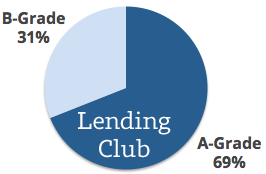 Because of his age and situation, Mitch has a low risk tolerance. If he would lose a portion or his entire invested cash, he has almost no ability to go back to work to make more. As a result, Mitch might want to safely allocate his Lending Club investment in As and Bs. If the American economy goes to pieces, Mitch will likely be more protected.
Because of his age and situation, Mitch has a low risk tolerance. If he would lose a portion or his entire invested cash, he has almost no ability to go back to work to make more. As a result, Mitch might want to safely allocate his Lending Club investment in As and Bs. If the American economy goes to pieces, Mitch will likely be more protected.
“Rita” from Rhode Island: A medium-risk investor
 Rita’s appraisal business has grown since its inception in 2009. At age 36 with two young boys, she stays quite busy each week. However, she and her husband have no debt at all besides the mortgage, and together earn over $240,000 per year. They are saving to send their kids to college, and have plenty of bills, but situation allows them to invest $15,000 of their savings into Prosper, which was mentioned on their favorite radio talkshow last month.
Rita’s appraisal business has grown since its inception in 2009. At age 36 with two young boys, she stays quite busy each week. However, she and her husband have no debt at all besides the mortgage, and together earn over $240,000 per year. They are saving to send their kids to college, and have plenty of bills, but situation allows them to invest $15,000 of their savings into Prosper, which was mentioned on their favorite radio talkshow last month.
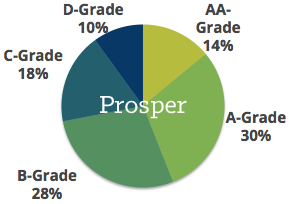 Rita might be an example of an investor with a more medium-degree of risk tolerance. While she and her husband have a lot of responsibility to manage, their healthy salary and relatively young age allow them to allocate a Prosper investment more broadly across many grades.
Rita might be an example of an investor with a more medium-degree of risk tolerance. While she and her husband have a lot of responsibility to manage, their healthy salary and relatively young age allow them to allocate a Prosper investment more broadly across many grades.
“Neville” from Nevada: A higher-risk investor
 If you ever go to Las Vegas and rent one of those outrageous Hummer limousines, you might catch a glimpse of Neville in the back of the store. Five years ago, his computer programming talent got noticed by the largest rental service in town, and now Neville manages hundreds of vehicles, programming the various touchscreens inside these party limos to play games, music, and spout interesting facts about the city. Neville is 28 with no kids or debt and plenty of savings. He earns an annual salary of $82,000, and just heard about Lending Club through a friend.
If you ever go to Las Vegas and rent one of those outrageous Hummer limousines, you might catch a glimpse of Neville in the back of the store. Five years ago, his computer programming talent got noticed by the largest rental service in town, and now Neville manages hundreds of vehicles, programming the various touchscreens inside these party limos to play games, music, and spout interesting facts about the city. Neville is 28 with no kids or debt and plenty of savings. He earns an annual salary of $82,000, and just heard about Lending Club through a friend.
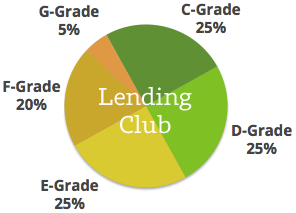 Because of his young age, respectable income, and few expenses, Neville’s risk tolerance is higher than most investors. If he put $7,500 to work at Lending Club that earned a negative ROI, it would not be a huge setback. As a result, he can afford to be less cautious and shoot for a higher return. His Lending Club account might be set up like this:
Because of his young age, respectable income, and few expenses, Neville’s risk tolerance is higher than most investors. If he put $7,500 to work at Lending Club that earned a negative ROI, it would not be a huge setback. As a result, he can afford to be less cautious and shoot for a higher return. His Lending Club account might be set up like this:
Most Investors Take on More Risk Over Time
If you are brand new to peer to peer lending, it is understandable that you are hesitant to take on very much risk at all. Opening your account and funding it with the $5,000 minimum may feel risky enough. As a result, you may start in the safer A and B-grade loans.
That said, most (diversified) investors have a great experience at Lending Club or Prosper, and eventually change their strategy to include riskier graded loans that are likely to give more return. In his Reader Story, Jack from Illinois summed up his change in risk tolerance quite nicely:
“I am happy with my returns since I changed my risk tolerance from ultra-conservative to somewhat aggressive. When we were coming off of the 2008 financial crisis, I only invested in A and B-grade loans. After a year, I switched my strategy to C-grade loans and below, since it seemed people were getting better returns in these riskier loans without a large increase in defaults. On Lending Club I went from an 8% to almost a 10% return in the past 18 months by switching to this strategy.” Read: Jack’s interview
The ability to self-select your risk remains one of the best parts of peer to peer lending, because it means we can tailor our investment’s potential to our particular situation. Investors with higher risk tolerance like myself are more than happy to stomach a 8% loss to defaults if it means earning a net 9% per year. Concurrently, investors with less risk tolerance are just as happy to earn a still-respectable 5% on safer loans that have a great default rate of just 1.6%.
Questions/comments? How does your life situation affect the grades you choose?
[image credit: Pink Sherbet Photography “Free Child Walking”
Kevin D “Untitled”
torbakhopper “The Old Man and the Sea”
Steve Wilson “Business woman”
Rob Boudon “Matt Siffert” all CC-BY 2.0]

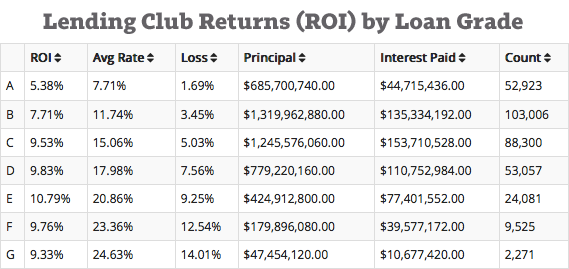
I really liked the article Simon, thank you. But I guess the next stage really is looking at this using a Sharpe Ratio to ensure that the Return received is in keeping with the true Risk one is taking on. That is, if we purely look at a say a Lending Club C grade loan returning 15% vs a D grade one at 18%. A Sharpe Ratio will examine whether the extra 3% of return earned is actually commesurate with the extra risk one has taken in stepping down a notch from C to D. It is a measure that is often used in examining performance of Hedge Funds, might be useful as a tool here as well. Not sure if anyone has incorporated this into their analysis?
Thanks Glenn. I’ll check that out. If you want to help shoot me an email.
Great article Simon. I think identifying one’s risk tolerance and/or ability to invest, not just for P2P, but for all asset classes is important. Speaking of myself, I know with P2P, I started out in the B-C-D range, and expanded to D-E-F, before settling on C-D-E-F. I want the base level of risk to be centered in the C-D range as this to me is the “sweet” spot between risk and returns for both bull and bear markets when default rates will fluctuate.
Thanks Adam. I may be moving in that direction myself.
Great reminder about risk vs return and one size not fitting all. It is very easy to get caught up in the “I want the highest return possible” mentality because it is easier to compare yourself with others. Risk is an important factor to consider but definitely not talked about much.
You don’t hear people say “my loss rate was 3 points below the average for my risk level” but you do hear people say “my return was 3 points above….”
Thanks again for that reminder.
I am interested in the idea of p2p lending with prosper and lending club. Do you think it would be worth it to invest just $150 in each just to learn the ropes and basics? Or is that amount too small and pointless? Thank you!
It’s probably fine as long as you know you have a much higher volatility with such a small amount, so you’re more likely to have a negative return.